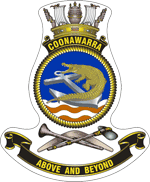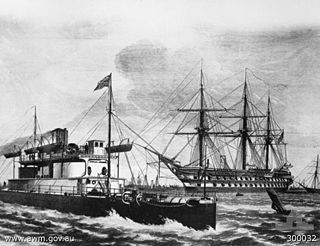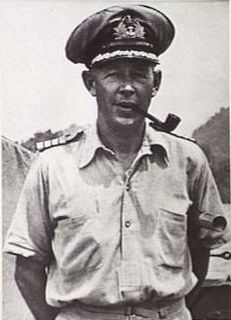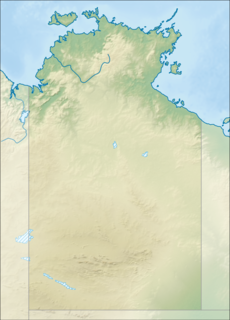
HMVS Cerberus is a breastwork monitor that served in the Victoria Naval Forces, the Commonwealth Naval Forces (CNF), and the Royal Australian Navy (RAN) between 1871 and 1924.
Three ships and two shore installations of the Royal Australian Navy have been named HMAS Penguin after the aquatic, flightless bird:

HMAS Cerberus is a Royal Australian Navy (RAN) base that serves as the primary training establishment for RAN personnel. The base is located adjacent to Crib Point on the Mornington Peninsula, south of the Melbourne City Centre, Victoria, Australia. The base is also an official bounded locality of the Shire of Mornington Peninsula and is the only naval base to have a specific listing in the Australian census. As at the 2016 census, HMAS Cerberus had a population of 1,040.

Hector Macdonald Laws (Hec) Waller, was a senior officer in the Royal Australian Navy (RAN). His career spanned almost thirty years, including service in both world wars. At the helm of the flotilla leader HMAS Stuart in the Mediterranean from 1939 to 1941, he won recognition as a skilful ship's captain and flotilla commander. He then transferred to the South West Pacific as captain of the light cruiser HMAS Perth, and went down with his ship against heavy odds during the Battle of Sunda Strait in early 1942.

HMAS Coonawarra is a Royal Australian Navy (RAN) base located in Darwin, Northern Territory, and is home to twelve fleet units of the RAN. The current commander is Commander Darren Rushworth, RAN.

Before Federation in 1901 five of the six separate colonies maintained their own naval forces for defence. The colonial navies were supported by the ships of the Royal Navy's Australian Station which was established in 1859. The separate colonies maintained control over their respective navies until 1 March 1901, when the Commonwealth Naval Forces was created.

The history of the Royal Australian Navy traces the development of the Royal Australian Navy (RAN) from the colonisation of Australia by the British in 1788. Until 1859, vessels of the Royal Navy made frequent trips to the new colonies. In 1859, the Australia Squadron was formed as a separate squadron and remained in Australia until 1913. Until Federation, five of the six Australian colonies operated their own colonial naval force, which formed on 1 March 1901 the Australian Navy's (AN) Commonwealth Naval Force which received Royal patronage in July 1911 and was from that time referred to as Royal Australian Navy (RAN). On 4 October 1913 the new replacement fleet for the foundation fleet of 1901 steamed through Sydney Heads for the first time.

HMAS Huon is a former Royal Australian Navy (RAN) base located in Hobart, Tasmania, Australia, in operation from 1911 to 1994.

Vice Admiral Sir Roy Russell Dowling, was a senior commander in the Royal Australian Navy (RAN). He served as Chief of Naval Staff (CNS), the RAN's highest-ranking position, from 1955 until 1959, and as Chairman of the Chiefs of Staff Committee (COSC), forerunner of the role of Australia's Chief of the Defence Force, from 1959 until 1961.

HMAS Maitland is a former Royal Australian Navy (RAN) shore-based naval depot located in the Hunter area, behind Horseshoe Beach and Nobby's Beach, in Newcastle, New South Wales, Australia.

HMAS Rushcutter is a former Royal Australian Navy (RAN) base that served as a depot, radar and anti-submarine training school located at Rushcutters Bay and Darling Point, in Sydney's eastern suburbs in New South Wales, Australia.

HMCSProtector was a large flat-iron gunboat commissioned and purchased by the South Australian government in 1884, for the purpose of defending the local coastline against possible attacks in the aftermath of the 'Russian scare', of the 1870s. She arrived in Adelaide in September 1884 and subsequently served in the Boxer Rebellion, World War I and World War II.
Five ships of the Royal Navy have been named HMS Cerberus or Cerbere after Cerberus, the three-headed dog in Greek mythology that guards Hades:

Rear Admiral Otto Humphrey Becher, & Bar was a senior officer in the Royal Australian Navy (RAN). Born in Harvey, Western Australia, Becher entered the Royal Australian Naval College in 1922. After graduating in 1926, he was posted to a series of staff and training positions prior to specialising in gunnery.
Vice Admiral Sir Guido James Willis was an officer in the Royal Australian Navy (RAN) who rose to the rank of vice admiral. He joined the RAN in 1937, saw active service during World War II and the Korean War, and was Chief of Naval Staff (CNS) from 1979 to 1982 before retiring.

HMAS Leeuwin is a former Royal Australian Navy (RAN) shore establishment, located in Fremantle, Western Australia. In use between 1940 and 1984, the base reopened in 1986 under the control of the Australian Army as Leeuwin Barracks.

HMAS Goorangai was a 223-ton auxiliary minesweeper of the Royal Australian Navy (RAN). She was built in 1919 for the Government of New South Wales, then sold in 1926 to the fishing company Cam & Sons. The trawler was requisitioned for military service following the outbreak of World War II, converted into a minesweeper, and assigned to Melbourne. She was sunk in an accidental collision with MV Duntroon in 1940, becoming the RAN's first loss of World War II, and the first RAN surface ship to be lost in wartime.

HMAS Melville is a former Royal Australia Navy (RAN) shore base located in Darwin, Northern Territory, in Australia. The base was in use between 1935 and 1974.

HMAS Lonsdale is a former Royal Australian Navy (RAN) training base that was located at Beach Street, Port Melbourne, Victoria, Australia. Originally named Cerberus III, the Naval Reserve Base was commissioned as HMAS Lonsdale on 1 August 1940 during the Second World War.
HMAS Kooronga was a 60-ton tug boat and training ship operated by the Royal Australian Navy (RAN). She was constructed at the Williamstown Dockyard, Victoria in 1917. Kooronga was commissioned on 6 June 1924 and named Cerberus II as a tender at the Flinders Naval Depot. The vessel was later renamed HMAS Kooronga. She ran aground in the Port Phillip channel and was stranded from 28 June until 14 July 1940. Upon being refloated she was refitted out.















